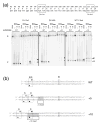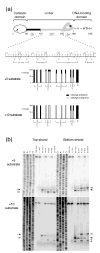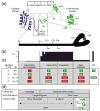Role of the interdomain linker in distance determination for remote cleavage by homing endonuclease I-TevI
- PMID: 18499124
- PMCID: PMC2699217
- DOI: 10.1016/j.jmb.2008.04.047
Role of the interdomain linker in distance determination for remote cleavage by homing endonuclease I-TevI
Abstract
I-TevI is a modular intron-encoded endonuclease, consisting of an N-terminal catalytic domain and a C-terminal DNA-binding domain, joined by a 75 amino acid linker. This linker can be divided into three regions, starting at the N terminus: the deletion-intolerant (DI) region; the deletion-tolerant (DT) region; and a zinc finger, which acts as a distance determinant for cleavage. To further explore linker function, we generated deletion and substitution mutants that were tested for their preference to cleave at a particular distance or at the correct sequence. Our results demonstrate that the I-TevI linker is multi-functional, a property that sets it apart from junction sequences in most other proteins. First, the linker DI region has a role in I-TevI cleavage activity. Second, the DT linker region participates in distance determination, as evident from DT mutants that display a phenotype similar to that of the zinc-finger mutants in their selection of a cleavage site. Finally, NMR analysis of a freestanding 56 residue linker segment showed an unstructured stretch corresponding to the DI region and a portion of the DT region, followed by a beta-strand corresponding to the remainder of the DT region and containing a key distance-determining arginine, R129. Mutation of this arginine to alanine abolished distance determination and disrupted the beta-strand, indicating that the structure of the DT linker region has a role in cleavage at a fixed distance.
Figures







Similar articles
-
Zinc finger as distance determinant in the flexible linker of intron endonuclease I-TevI.Proc Natl Acad Sci U S A. 2002 Jun 25;99(13):8554-61. doi: 10.1073/pnas.082253699. Epub 2002 Jun 19. Proc Natl Acad Sci U S A. 2002. PMID: 12077294 Free PMC article.
-
Distance determination by GIY-YIG intron endonucleases: discrimination between repression and cleavage functions.Nucleic Acids Res. 2006 Mar 31;34(6):1755-64. doi: 10.1093/nar/gkl079. Print 2006. Nucleic Acids Res. 2006. PMID: 16582101 Free PMC article.
-
Selection of a remote cleavage site by I-tevI, the td intron-encoded endonuclease.J Mol Biol. 1995 Mar 24;247(2):197-210. doi: 10.1006/jmbi.1994.0133. J Mol Biol. 1995. PMID: 7707369
-
Redox-responsive zinc finger fidelity switch in homing endonuclease and intron promiscuity in oxidative stress.Curr Biol. 2011 Feb 8;21(3):243-8. doi: 10.1016/j.cub.2011.01.008. Epub 2011 Jan 20. Curr Biol. 2011. PMID: 21256016 Free PMC article.
-
Three-dimensional structural views of damaged-DNA recognition: T4 endonuclease V, E. coli Vsr protein, and human nucleotide excision repair factor XPA.Mutat Res. 2000 Aug 30;460(3-4):257-75. doi: 10.1016/s0921-8777(00)00031-8. Mutat Res. 2000. PMID: 10946233 Review.
Cited by
-
Biasing genome-editing events toward precise length deletions with an RNA-guided TevCas9 dual nuclease.Proc Natl Acad Sci U S A. 2016 Dec 27;113(52):14988-14993. doi: 10.1073/pnas.1616343114. Epub 2016 Dec 12. Proc Natl Acad Sci U S A. 2016. PMID: 27956611 Free PMC article.
-
A Photoresponsive Homing Endonuclease for Programmed DNA Cleavage.ACS Synth Biol. 2024 Jan 19;13(1):195-205. doi: 10.1021/acssynbio.3c00425. Epub 2023 Dec 7. ACS Synth Biol. 2024. PMID: 38061193 Free PMC article.
-
Perpetuating the homing endonuclease life cycle: identification of mutations that modulate and change I-TevI cleavage preference.Nucleic Acids Res. 2016 Sep 6;44(15):7350-9. doi: 10.1093/nar/gkw614. Epub 2016 Jul 7. Nucleic Acids Res. 2016. PMID: 27387281 Free PMC article.
-
Scientific serendipity initiates an intron odyssey.J Biol Chem. 2009 Oct 30;284(44):29997-30003. doi: 10.1074/jbc.X109.055400. Epub 2009 Aug 26. J Biol Chem. 2009. PMID: 19710025 Free PMC article. No abstract available.
-
The monomeric GIY-YIG homing endonuclease I-BmoI uses a molecular anchor and a flexible tether to sequentially nick DNA.Nucleic Acids Res. 2013 May 1;41(10):5413-27. doi: 10.1093/nar/gkt186. Epub 2013 Apr 4. Nucleic Acids Res. 2013. PMID: 23558745 Free PMC article.
References
-
- Gokhale RS, Khosla C. Role of linkers in communication between protein modules. Cur Opin Chem Biol. 2000;4:22–27. - PubMed
-
- Wriggers W, Chakravarty S, Jennings PA. Control of protein functional dynamics by peptide linkers. Biopolymers. 2005;80:736–46. - PubMed
-
- Van Roey P, Derbyshire V. GIY-YIG homing endonucleases - beads on a string. In: Belfort M, Derbyshire V, Stoddard BL, Wood DW, editors. Homing Endonucleases and Inteins. Springer-Verlag; 2005. pp. 67–83.
Publication types
MeSH terms
Substances
Grants and funding
LinkOut - more resources
Full Text Sources
Other Literature Sources
Molecular Biology Databases

